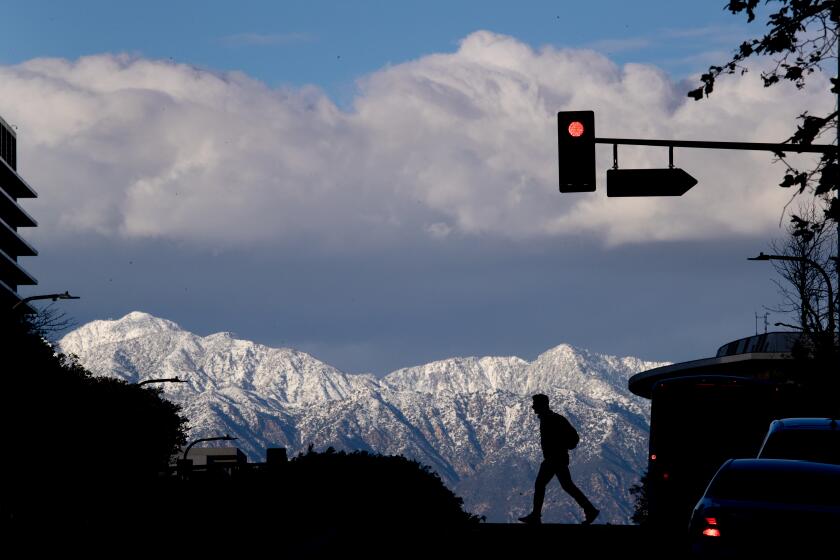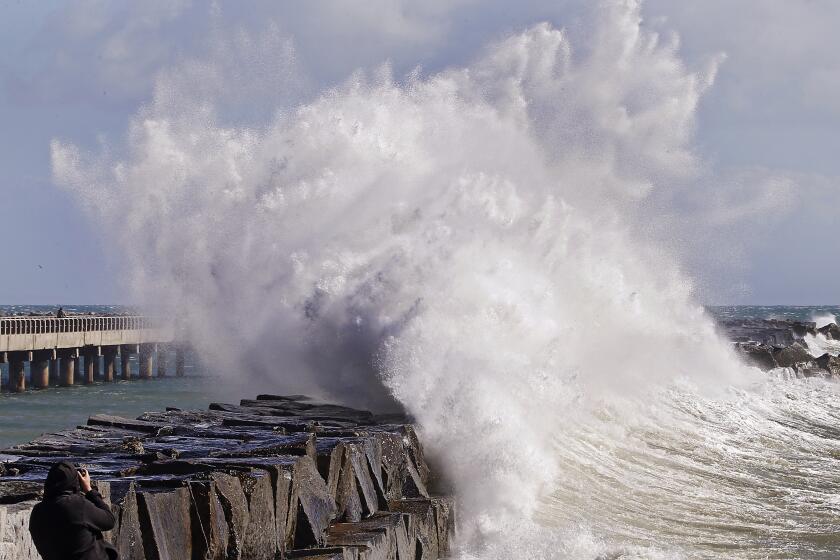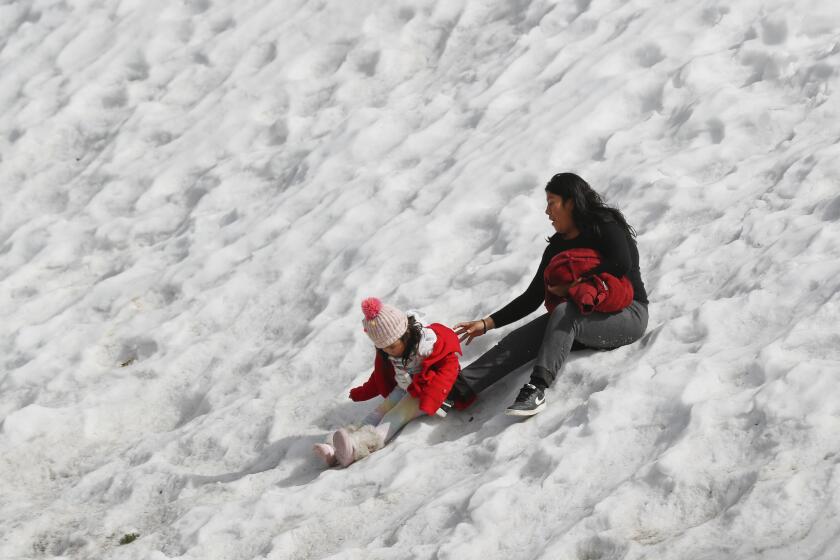Snowmaker storm of epic proportions moving into SoCal: ‘We’re getting the full brunt’
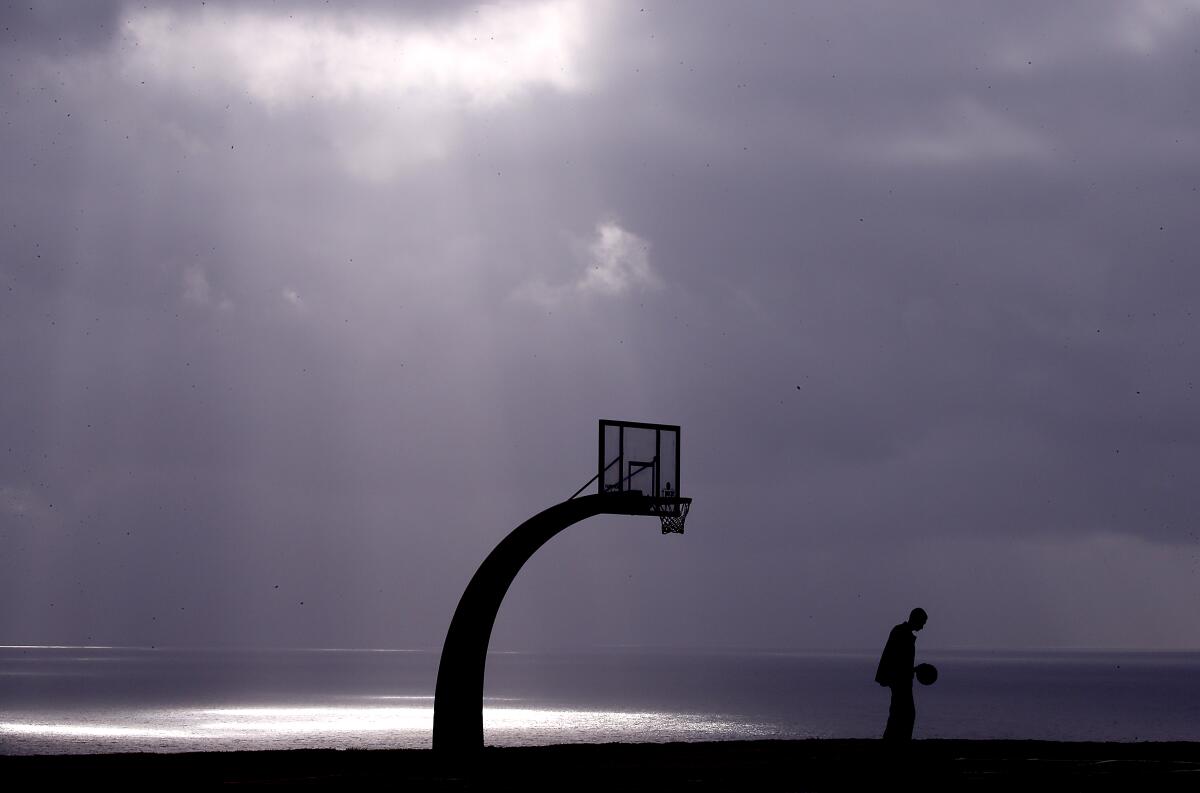
- Share via
It has the potential to be a snowmaker of epic proportions: A brutal winter storm moving through California is slated to drop rain, sleet and snow from the Oregon border down to the deserts near Mexico.
Forecasters say “all eyes” are on Thursday through Saturday, when even Southern California could see several feet of fresh powder in the mountains around Los Angeles. The National Weather Service has issued a blizzard warning in the L.A. and Ventura County mountains — only the second time such a warning has been issued, following a similar storm in 1989.
“It’s bringing all of that cold air down to Southern California — we’re getting the full brunt,” said meteorologist David Sweet of the incoming system.
Scenes from across Southern California, where a powerful winter storm dumped heaps of snow and record-setting rain.
Temperatures were expected to be as much as 20 degrees below normal, and by Wednesday afternoon, snow was already starting to fall in portions of the Antelope Valley, while hail was pounding the pavement in Highland Park and Pasadena. Residents reported a dusting of snow in La Crescenta, and 50 mph gusts battered Thousand Oaks and Agoura.
“It’s got the cold air, it’s got the moisture, it’s got strong winds,” said Sweet, who works with the weather service in Oxnard. “It’s an ideal situation for a big weather maker with huge impacts.”
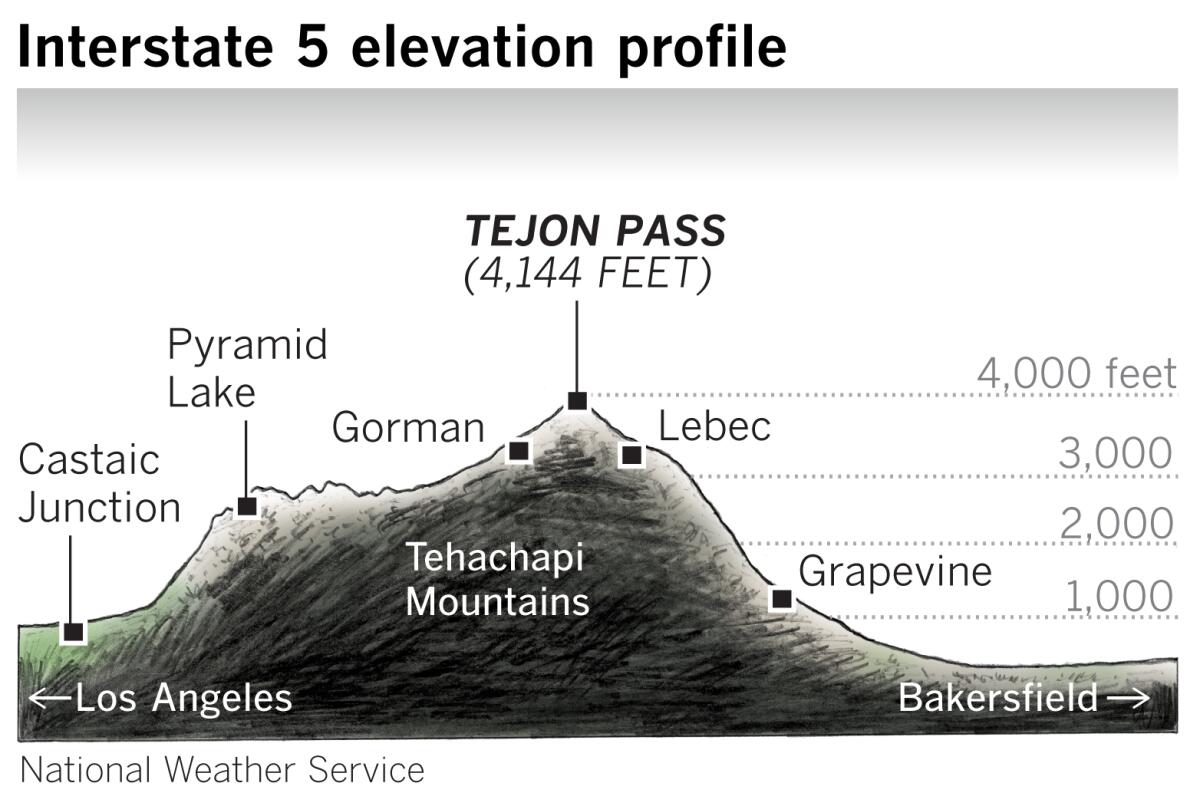
In the Los Angeles area, snowfall totals at 4,500 feet elevation or higher could be as much as 5 feet, with some isolated instances of up to 8 feet of snow, according to forecasters. Areas with elevations from 2,500 to 4,000 feet — including the Tejon Pass — could see as much as 12 inches of snow, while areas at 1,500 to 2,500 feet could see up to 4 inches, including the Antelope Valley.
The weather service also issued a flood watch for large swaths of Ventura and Santa Barbara counties, where as much as 5 inches of rainfall is possible between Thursday night and Saturday afternoon.
This week’s storm is unusual even in a winter of unusual events, climate experts say. The state already defied forecasts for a dry winter driven by La Niña when a series of nine atmospheric river storms pummeled California in January — the wettest three-week period on record, according to state officials.
Early February was marked by a notable return to dryness, with less than an inch of precipitation falling statewide. Now, residents are being battered by winds and facing hazardous driving conditions and snow. Should forecasts manifest, the L.A. and Ventura County mountains could receive the “largest amount of 24- [to] 48-hour snowfall seen in decades,” rivaling the winter storm in 1989, the weather service said.
Snow has already started to fall in the Antelope Valley, and forecasters are warning of possible dangerous conditions that could last through Sunday.
Daniel McEvoy, a regional climatologist with Western Regional Climate Center, said the rare system is part of a larger-scale circulation pattern in the Western U.S. that has been in place through much of winter and has locked in a lot of cold air.
“This has been one of the coldest winters in many decades for a lot of places,” McEvoy said, “so the fact that we’re having another cold storm this winter is not that surprising, but the magnitude — and how the ingredients are setting up to impact Southern California especially — is looking pretty rare.”
The low-pressure system originated off western Canada, he said. Within the system are multiple “waves of energy” driven by the flow of the jet stream, or the air currents in the upper level of the atmosphere that guide weather systems from west to east.
Though it is not like the “classic” atmospheric rivers that hit the state in late December and early January, the system will connect with moisture over the Pacific as it moves south, signaling heavy rain and snow.
The effects of the storm are expected to be wide-ranging and potentially dangerous across California, including “large swaths of our interstates and highways covered in snow,” said Hannah Chandler-Cooley, a meteorologist with the weather service in Sacramento. The agency is advising people to avoid travel, particularly between Thursday afternoon and Friday, and to be prepared for hazards such as downed trees and power outages.
By Wednesday evening, reports of snow and graupel — or soft hail — were pouring in from residents in several areas across the state, including downtown Sacramento, the San Joaquin Valley and the Santa Cruz Mountains, with officials warning of more severe inclement weather.
Around Sacramento, the area of main concern is the foothills and mountains, as well as the Northern Sacramento Valley, where snow could be at elevations as low as 500 feet — basically down to the valley floor, Chandler-Cooley said.
In the San Francisco Bay Area, the best chances for accumulation are around the Santa Lucias on the Central Coast, according to NWS meteorologist Brayden Murdock. Though the storm has been relatively dry so far, it will soon gain some moisture as it pushes its way south toward L.A., he said.
“This is a rare setup for us,” Murdock said. “If this whole system was pushed a little more off to the east, it probably would have been more of a dry, strong wind event, but since it gets the opportunity to interact with the Pacific, that’s why we’re getting all this moisture on top of it.”
Already, high winds in the Bay Area have toppled garbage bins, basketball hoops and shopping cart holders. On Tuesday afternoon, a gust of 73 mph was clocked on the Golden Gate Bridge, while a wind gauge at San Francisco’s Twin Peaks measured one at 63 mph.
Firefighters and law enforcement responded to a series of felled trees and limbs, including a eucalyptus that dropped onto the westbound lanes of Interstate 80 on the Bay Bridge, blocking the tunnel. And the roof of at least one building in San Francisco partially blew off.
Power outages in Northern California and the Central Coast were also widespread — more than 172,000 at the peak Tuesday night — and several communities, homes and businesses were still without power on Wednesday. In Menlo Park, traffic lights from the 101 Freeway to El Camino were largely out of service.
Farther inland, a six-mile stretch of Interstate 15 near California’s border with Nevada was closed in both directions for about 12 hours Wednesday because of icy road conditions as the beginnings of the storm moved into the region.
The storm is expected to be ‘a snowmaker of the likes we have not seen for many years,’ a forecaster said, with a chance for snow even at sea level.
Meanwhile, Southern California was bracing, with rain and snow expected to ramp up late Thursday into Friday.
“All systems go for a major and unusual storm,” the weather service said in its afternoon update.
Palmdale resident Tommy Perez, 41, said he remembered when the area saw 2 feet of snow about five years ago.
Perez, who was picking up a meal from California Fish Grill, said he and his family had heard about the incoming storm and decided to pack snow chains in case road conditions became difficult.
For the record:
6:02 p.m. Feb. 23, 2023An earlier version of this article referred to California Fresh Grill. The restaurant was California Fish Grill.
“We got stuff for the car just in case,” Perez said.
California Department of Transportation spokesman Marc Bischoff said the agency was already staffing crews around the clock on the Grapevine, where they’re readying snowplows and spreading salty brine on the roads to keep them from icing up.
“We’re always concerned about the mountain areas because that’s where precipitation hits first, and particularly because the snow levels are going to be so low and temperatures are going to be so cold,” Bischoff said. In addition to the Grapevine, other areas of focus for CalTrans included State Routes 14, 58 and 33, as well as State Routes 2 and 39 in the Angeles National Forest.
“For the duration of the storm, if you don’t need to drive somewhere on any of those roadways, then don’t go — that’s the best choice you can make,” he said. He added that State Route 33 had been closed since the atmospheric river storms in January, so those tempted to take that roadway to look at the snow can “save themselves a trip.”
Referring to last fall’s seasonal outlook that called for another dry winter, McEvoy, the climatologist, said the moist system speaks to the challenges of long-term forecasting. Since about November, the jet stream has been digging out an area of low pressure that has been persistent over much of the West Coast.
“The atmosphere has gotten locked into this pattern this winter, and it doesn’t look like it’s going to be breaking anytime soon,” he said. “This is a pattern we haven’t really seen in a long time in the West.”
But skies were still blue in Tejon Pass on Wednesday afternoon, where Bakersfield resident Jenifer Natto was doing some shopping. Natto said she wasn’t worried about the storm, even though her house lost power Tuesday night due to intense wind.
“I have plenty of food and a gas fireplace,” Natto said, adding that she intends to stay indoors while the storm passes through. “I’m not planning on going anywhere this weekend.”
More to Read
Sign up for Essential California
The most important California stories and recommendations in your inbox every morning.
You may occasionally receive promotional content from the Los Angeles Times.
